The following designs are solely the property of Design Wizardry studios and myself,
company founder, Mike Carambat. These designs have been independently designed and researched.
To my knowledge, these ideas are unique and do not appear in any recorded telescope history.
Any similarity or inspiration due to pre-existing designs has been noted where applicable.
|
WHO AM I? I am an amateur astronomer with just enough knowledge of telescope optics and design to be dangerous. I am by trade a graphic artist and website designer, with astronomy as a hobby. I also have been tinkering and inventing things since I was born. To put it simply, DaVinci is my hero. Telescope design is a new field for me, and I am still learning. However, my enthusiasm for telescope design has been at a fever pitch recently and what I don't know I try to find out. So you could say my extent of optics reaches only as far as the designs you see below. I try to 3D model or actually build as many as possible for testing. But due to my own limitations in construction materials and tools, or limitations in my 3D software, some of these cannot be built 100% to be tested, thus remain theoretical. If any of my designs or assumptions look incorrect to more experienced eyes, please let me know. I would be very interested in any comments WHY COME UP WITH A COMPLETELY NEW TELESCOPE DESIGN? Well, mostly because I think it's cool to come up with something no one has ever thought of before. I do not subscribe to the idea that there's nothing new under the sun. People should try to originate new ideas. Secondly, current telescope design has problems which I believe can be answered in more effective ways. Good telescopes cost alot of money. This is because you are paying for exotic materials and complicated fabrication methods. There simply must be a way to make a better quality telescope for less cost. Also, even if cost isn't an issue, there are still limitations which I believe can be overcome in event the most current telescope design. OKAY, HERE'S WHAT I'VE COME UP WITH SO FAR The Cylindrical Mirror Telescope - 2/3/05 The cost of a large parabolic mirror is what drove this project. Why not use a large flat mirror and simply bend it into a cylindrical parabolic curve? Well, because you would only magnify the image in one dimension. So, I came up with the idea of first magnifying the vertical, then using another mirror to magnify the horizontal, thus resulting in a square magnified image. This concept actually works, but uses alot of mirrors which must be precisely curved and aligned. Thus very difficult to make by hand. At best, I was able to 3D model and test it. In addition, while researching this project I came across Bruno Postle's website which had an almost identical cylindrical mirror design to mine! The combination of hard to make prototype and the fact someone else had the idea before me, pretty much put an end to further development. [More pictures and details to come] The Axial Reflecting Telescope - 2/11/05 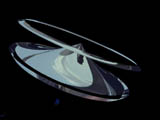 This is by far the most unusual design for a telescope I have ever seen. I came up with it by simply wanting to remove the obstruction from the primary mirror of a newtonian scope. I got on a train of thought that led to this wild invention. This is by far the most unusual design for a telescope I have ever seen. I came up with it by simply wanting to remove the obstruction from the primary mirror of a newtonian scope. I got on a train of thought that led to this wild invention.The idea is that the light enters through the top parabolic ring then hits the large inverted parabolic mirror. The light is then reflected and focused to the inside of the top parabolic ring. Being of the same curve as the large inverted parabolic ring, the light is then collimated and directed downward. So, now you have a tunnel of collimated light moving down. It then hits the 45 degree lower ring, which then directs the light back to the center of the device hitting the small 45 degree inner cone. This then sends the now magnified image to your eye as a collimated light beam. A very cool idea. Very little obstruction (only the three thin vanes needed to hold the inner mirrors to the outer body), very low profile, and very adjustable for focal length: 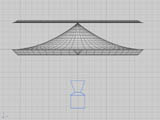 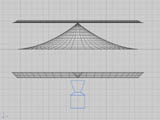 But, very difficult to fabricate and very susceptable to temperature changed. If any of the many exotic mirrors shrinks or expands in disrespect to the other, the whole thing is botched. Here is the target image before and after magnification through the scope: 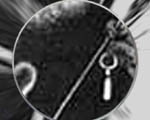 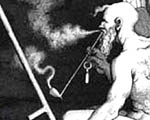 The Spinning Parabolic Telescope - 2/18/05 Large parabolic mirrors cost serious bucks. So, why not make it out of lots of strips of flat mirrors and then spin the whole arrangement to make one solid parabolic? Well, after actually building one, I'll tell you. Yes, you get a large parabolic mirror, but it's opacity is less than a regular solid one because of the space between each strip. Much like the way you can look through a spinning ceiling fan. Also, the strips have to be unbelievably thin or you get multiple focal points per strip, greatly distorting the image. Lastly, vibration from the spinning is a nightmare if you're building one of these at home. I gave up after spending way too much time on this idea. [Pictures and details to come] The Segmented Mirror Telescope - 2/22/05 Another insane idea using many mirrors to get around the obstruction in the primary. Because it has so many twists and turns, it's not very practical. I didn't even bother to 3D model this one. [More pictures and details to come] The Periscope Telescope - 2/25/05  I am most excited about this design. it's simple, easy to make and inexpensive. In fact, I have made a working prototype! It is a modified Newtonian design. You basically enlarge your secondary mirror to the size of the primary and turn your light path backwards. Thus the light now comes in at the secondary mirror which reflects it like a periscope to the primary. The primary then focuses it to a point back on the secondary mirror where you have neatly drilled a 1/4" hole. The convering beam then turns into a diverging beam at this nadir point. So now you have a diverging beam coming out the back of the secondary mirror. You then use a achromatic lense? to convert the diverging beam back into a converging beam and put your eyepiece at the back of the scope. Unbelievably simply design. I am waiting on the right optics to complete my prototype. Right now, I am using a old double-convex lense to make a collimated beam to by eye. When I get my achromat, I will be able to use my 2" eyepieces and see exactly how cool this scope is! UPDATE 2-27-05: I have just found out that this idea has indeed been thought of before. During the 1920's R.W. Porter created the Porter Turret telescope which is remarkably similiar in design to mine. Mine having the exception of a much smaller hole in the secondary because I pass the beam through the mirror at it's nadir and use a lense to reconverge. Porter's design intercepted the beam as it was converging, thus needing a much larger hole. Here's a great website about it's history: Stellafane Museum [Pictures and details to come] The Double Scope - 3/25/05  Another neat, inexpensive and easy to make design. I have made a working prototype of this one as well with great success!
Another neat, inexpensive and easy to make design. I have made a working prototype of this one as well with great success!This design is similiar in principle to a design I've seen with solar viewing. You use a large solar filter at 45 degrees completely blocking a standard Newtonian design's aperature. Bright solar light passes through the filter, reflects off the primary mirror inside which reflects the light back to the highly reflective side of the filter. This reflected light exits out the side of the tube into the eyepiece. A neat idea, but it would be useless for night viewing as the dim starlight is not capable of passing though the filter. So I tried using a much less dense type of one-way mirror. I found experimentally (using a variable beamsplitter) that a 25% reflective, 75% pass-through piece of one-way glass will yield the brightest resulting image. I had even tried totally clear plate glass, but apparently, plate glass has a poor reflective capability but is much better than standard 50%-50% store-bought one-way glass. A peice of 25%-75% one-way glass will net about 60% of original light at the eyepiece. Because of this, it is still not a satisfactory design to replace the basic Newtonian, but it has some neat side-effects... I discovered also that the design will yield a double image in the eyepiece as the diverging beam hits both the inner surface and outer surface of the glass on the return trip. This creates a double image with one a bit larger than the other because of the increase in focal length which is proportional to the width of the glass. Although annoying, it doesn't distort the viewability of the primary image. However, I have discovered that increasing the width of the glass (increases the distance the beam will travel due to refraction) and it will move the double image much further away from the primary eyepiece, thus allowing the placement of TWO eyepieces side-by-side! This allows you to have a wide field in one, and a higher power in the other!!! No more adjusting your sighting scope! In this design, what you see in the sighting eyepeice is what you will see in the other!! |